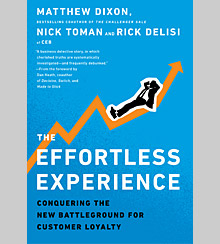When It Comes to Customer Service, Don’t Say No
Lewis P. Carbone, author of Clued In: How to Keep Customers Coming Back Again and Again, introduces an excerpt on how to eliminate negative cues from The Effortless Experience: Conquering the New Battleground for Customer Loyalty, by Matthew Dixon, Nick Toman, and Rick DeLisi.
The mind is a powerful thing. But almost all our mental processing takes place unconsciously; neuroscience suggests that as few as 5 percent of a person’s decisions are based on conscious, rational thought. Whether companies realize it or not, they’re constantly delivering clues that influence their customers’ unconscious thinking—shaping their impressions and ultimately, their actions.
Consider customer service. Chances are you have bailed on a company you’d been satisfied with for years because of a bad experience with its customer service department. (Many of us would: In a 2013 Mitel survey of 2,000 adults in the U.K., 74 percent of the respondents said they would change suppliers after a poor experience with a customer service department.) But chances are you would have stayed with the company if its customer service reps had just made it easier for you to place your order or resolve your problem.
This doesn’t mean that customers expect to be swept off their feet by customer service reps. What they really want, explain Matthew Dixon, Nick Toman, and Rick DeLisi, is an “effortless” experience. In the following passage from their new book, The Effortless Experience, you’ll learn how one manufacturer found a simple way to help its customer service reps deliver such experiences. No hoopla. No fanfare. No heroics. Just a set of simple statements that eliminated the negative emotional cues associated with the most common problems its customers encounter, reduced costs, and enhanced customer satisfaction.
—Lewis P. Carbone
An excerpt from chapter 4 of The Effortless Experience:
Conquering the New Battleground for Customer Loyalty
You can’t always say yes to every customer request. It would be great if you could, but there are many situations in which the thing a customer wants and the thing you have to give are not the same. Then what?
Well, of course, the opposite of yes is...no. So let’s consider the word “no” for a moment. How do you react when you hear that word? For most of us, “no” is a trigger that sets in motion an entire chain of negative emotions. Anger, outrage, argumentation. These are all baked into our DNA. Somewhere between your sixth and twelfth month of life, you first made a realization that has stuck with you until this day:
If Mommy says no, you have three options:
- Accept it and move on (unlikely).
- Go ask Daddy (since you’ve still got a 50/50 shot of getting a yes from him).
- Or kick and scream to show your displeasure, hoping your outburst will change the no into a yes.
In a service interaction, when most customers hear “no,” they do one of a number of things—all of which are pretty bad outcomes for the company (and not all that different from how we responded when we were children):
- Engage in some emotional response: Argue with the rep, get angry, use foul language, create some kind of outburst.
- Hang up, call back, and try again with another rep, often called “rep shopping.” This, of course, is the customer version of the “go ask Daddy” reaction.
- Escalate the call: By asking the rep to transfer you to their supervisor, you’re playing a more savvy version of the rep-shopping game, since most customers have learned that the supervisor has more authority to waive annoying fees, substitute higher-priced products without an additional charge, and generally bend the rules.
- Threaten to never do business with the company again: Sometimes this is just a veiled threat, and sometimes it’s sincere. Regardless...even if it’s just bluster, it’s bluster that a customer can easily share with anyone and everyone who will listen, thanks to the digital soapbox that social media gives us.
That’s a lot of bad outcomes just because of one word. So, of course, it only makes sense that you’d want your people to avoid using it as much as possible. Reps need to find a way to both be truthful (because the answer in many cases is, unfortunately, still no), but in a way that doesn’t trigger the negative emotional reaction and all the bad outcomes that come along with it. This is where the use of positive language can make such a big difference....
That strategy is exactly what Osram Sylvania has developed with their frontline contact center reps. But rather than try to get all their reps to master the art of positive language and completely rewire their brains about how to react when talking to customers about every imaginable scenario, the company has created a simple tool that helps reps avoid negative emotional reactions in only the situations that occur most frequently.
They started by analyzing their highest-volume incoming customer requests—the issues that come up most often—and then they listened to how frontline reps responded when it became apparent that the customer was not going to get what they wanted. What they discovered—and we think this is very likely similar for most companies—was that the top ten most frequently occurring negative scenarios represented approximately 80 percent of their total volume of “no” situations.
So if they could just teach their reps how to use a simple response substitution when these situations came up—try saying this instead of saying that—not for every customer issue, but for these ten specifically, it would have a significant impact on a customer’s interpretation of effort and a positive impact on future loyalty. This is all presented in the form of a simple chart that every rep has pinned up in front of them at their workstation....
In Osram’s case, instead of saying, “We don’t have that item in stock right now,” their cheat sheet instructs them to say “We will have availability on [date] and I can get that out to you immediately once it comes in.”
The rep acts as the customer’s advocate—she’s the person who’s on your side and is doing everything she can to make this an easy, low-effort experience. Sure, she can’t create stock that doesn’t exist and hand it to you over the phone, but here’s what she can do—create a positive conversation that moves forward rather than backward. It’s a seemingly tiny little thing, but think about how these situations become amplified over thousands and thousands of customer interactions every day, mitigating the corrosive effect of negativity and its impact on customer loyalty. It all adds up and has a meaningful impact on customers.
Osram Sylvania discovered that while there might have been a case for teaching their reps how to use positive language on every single imaginable interaction, even just providing a simple tool that covers only the ten situations that come up most frequently still had a markedly positive result. Once the tool was in place, escalation rates (the percentage of calls that required the intervention of a supervisor) decreased by about half, and the overall Customer Effort Score reported by its customers improved by 18.5 percent, putting them well above average for similar B2B organizations.
Again, this isn’t just about being nice to customers. Nor is it just about using positive words. It works because Osram Sylvania teaches its reps the best way to react in the most common situations where we are very likely to be entering into the high-effort zone, since saying no (as well as words like “can’t,” “won’t,” “don’t,” etc.) is such a huge effort trigger....
Just because there’s nothing you can do, doesn’t mean there’s nothing you can do.
—Matthew Dixon, Nick Toman, and Rick DeLisi
Reprinted by permission of the publisher. © The Corporate Executive Board Company, 2013




